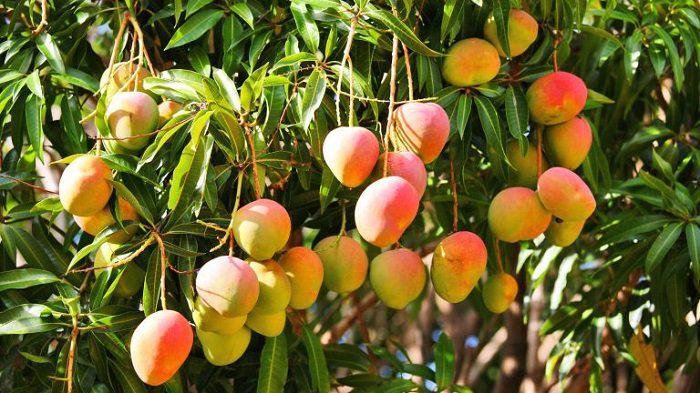Contents

How to choose the right mango?
Mango – an exotic fruit widely used in cooking. It can be eaten in its pure form, but most often it is used as an additional ingredient to salads or main courses. Mango has a specific taste, which allows you to combine it not only with sweet, but also meat products. On store shelves, you can see many varieties of these fruits, differing in hardness, shape and color of the peel.
Mango can be:
- green;
- black
- red;
- yellow;
- purple.
In shape, mango fruits can be elongated, ovoid, almost round, or pear-shaped. The form does not affect the taste, it only indicates that the fruit belongs to a certain type… The rarest type of mango is considered to be the flat type.
When choosing a particular option, first of all, you should determine in which dish this fruit will be used. Some types of mango are suitable for salads, others are suitable for consumption in their pure form, and others are suitable for combination with meat or fish. Unripe fruits are widely used in the treatment and stabilization of the intestines, and ripe fruits are used in dietology and cooking.

How to tell a ripe mango from an unripe fruit
You can determine the degree of ripeness of a mango by the appearance of the fruit or by the consistency. During the visual assessment, attention is drawn to the firmness and tone of the skin.
Ripe mango is distinguished by the following features:
- the size of a ripe fruit on average reaches 10-15 cm in diameter;
- shiny peel with black dots (color does not matter in this case);
- when pressing on the fruit, no dents remain, but the peel should be slightly pressed (not to be confused with completely soft mangoes);
- rich aroma, perceptible even through the skin (the smell is more intense at the place of fruit breakdown);
- the pulp of a ripe mango is always soft, fibrous and has a rich orange or yellow hue;
- the stalk area is always round;
- the pulp is easily separated from the stone.
Check the degree of softness of the mango by pressing your fingers, and squeezing the fruit in your palm. The firmness of the fruit in this case will indicate its ripeness. If the fruit resembles a stone, then this factor indicates its immaturity.
Signs of an overripe mango:
- the presence of a sour or “alcoholic” smell;
- too soft consistency, reminiscent of pumpkin porridge;
- dents or numerous scars on the skin.
Overripe mangoes have a sour aroma or pungent alcoholic odor due to their high sugar content. This component gradually begins to ferment, as a result of which not only the appearance of the mango is disturbed, but also its taste. Such fruits are unsuitable for human consumption.
Can unripe mangoes be eaten?
Mango is eaten not only in ripe form, but also unripe. Overripe fruits are not used in cooking due to their specific taste and sour aroma. When ripe, mango changes the composition of useful elements and vitamins. Unripe fruit contains a lot of starch and pectin. Gradually, these substances are converted into sucrose, maltose and glucose, and the amount of pectin is significantly reduced.

Signs of an unripe mango:
- solid fruit;
- pulp with a green tint;
- there are no black dots on the peel (some varieties of mango, in their mature form, also do not acquire specks on the peel, therefore this sign cannot be called a key sign);
- the bone is poorly separated from the pulp;
- lack of rich aroma;
- unripe mango is always lighter than ripe fruit;
- the stalk area is oval or elongated;
- sour or sour taste.
If buying a ripe mango becomes a problem, then you can buy unripe fruits and wait for them to ripen.… It is recommended to put the fruit in a paper bag and wait a few days. In the refrigerator, mangoes not only do not ripen, but can quickly deteriorate. Only ripe fruits should be stored in the cold. You can speed up the ripening process of a mango by placing an apple or a banana next to it.
In the homeland of exotic fruits, they are also quite often removed from trees unripe. Such actions are primarily due to the intention to preserve the fruits from the birds. Ripening mango in room conditions can be used if necessary, but it is better to buy it ripe.
The benefits of mango
By its composition, mango is considered one of the record holders for the content of vitamins and nutrients. Its regular use in food contributes to the normalization of metabolism and the work of all body systems.
The composition of mango contains the following vitamins and useful elements:
- 12 amino acids vital for the human body;
- herbal tranquilizers;
- enzymes that help slow the development of cancer cells;
- glutamic acid.
Read the full article on the benefits of mango on our website:
Before use, the peel is removed from the mango and the stone is removed. If there are signs of overripening, it is better to refuse tasting the fruit.










